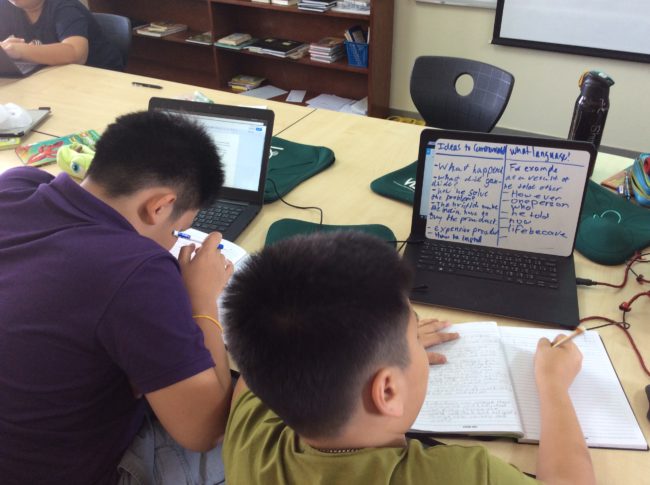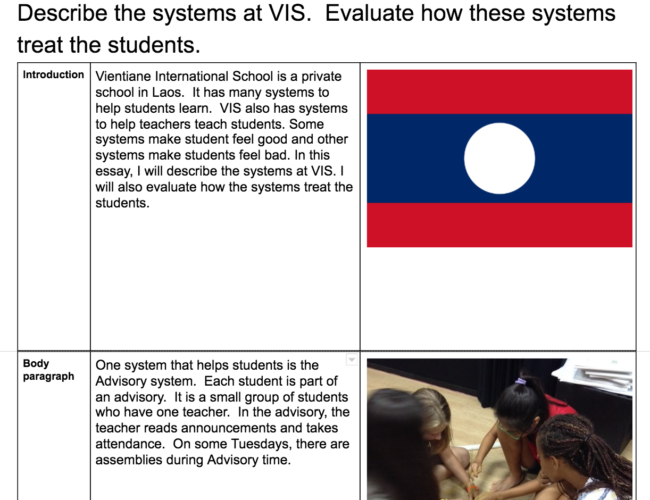Guiding Questions
- How can teachers support ELs development of writing skills?
- How can ELs foster an awareness of different writing genres?
Goal
The goal of this article is to describe a process of deconstructing mentor texts to help develop ELs’ writing skills.
Research Suggests
Martin and Rose (2012) suggest that learning a language is most effective when a more knowledgeable person offers guidance to the learner in a shared context.
For example, an older sibling may teach his younger sister colors by building a structure of just blue and yellow blocks. The brother is indirectly teaching his sister words such as “blue, yellow, blocks, build, put, here” and many more. She is learning all these words in context through a share social interaction.
Therefore, successful language learning requires social interactions, shared context, and scaffolding in order to prosper (Riddett, 2015; Hyland, 2014; Gibbons, 2009). The deconstruction model of teaching genre-based writing (Derewianka & Jones, 2013) contains these elements.
Past Practices
Mistake #1: Idolizing the Grecian Urn
In Kelly Gallagher’s Teaching Adolescent Writers (2006) he talked about his own writing instruction mistake, which he termed the “Grecian Urn.” Gallagher would draft and revise his own piece of writing that answered the prompt, and his composition would have earned him the highest score possible. He then would show his “Grecian Urn” to students hoping to inspire
Gallagher would draft and revise his own piece of writing that answered the prompt, and his composition would have earned him the highest score possible. He then would show his “Grecian Urn” to students hoping to inspire
He then would show his “Grecian Urn” to students hoping to inspire writing of a similarly high caliber. I used this approach the semester after I had used the “Write by Number” method.Unfortunately, the “Grecian Urn” also failed to develop students’ writing skills. The process of writing – brainstorming, drafting, revising, editing – had
Unfortunately, the “Grecian Urn” also failed to develop students’ writing skills. T The process of writing – brainstorming, drafting, revising, editing – had became invisible. ELs saw the end product but the process of writing was never modeled to them step-by-step. Consequently, the end product became not just invisible, but unattainable.
Mistake # 2: Playing a “Write by Number” Game
Many of you know of a children’s coloring game called “Color by Number”, in which you color in an object using the color associated with a number. When I visited an English class at a “high-performing” New York City charter school for professional development, the teacher had a “Write by Number” instructional approach.
She had drafted 90% of the words in the essay and simply wanted the students to complete the rest by filling in the empty spaces. Amazingly, all the transitions were already written in, all the main points were organized into paragraphs already, and the introductions and conclusions were awaiting only a thesis statement.
For one semester of English class, I borrowed this approach, and then almost immediately regretted it. I realized that, by writing 90% of the essay, I had also taken away 90% of the thinking students had to do. After one frustrating semester of trying this “Write by Number” approach, I quickly abandoned it.
These two past practices because they did not model the decisions writers make when crafting ideas. The Grecian Urn simply showed ELs the end product without interacting with the process. “Write by Numbers” took the thinking out of writing and essentially didn’t demonstrate the writing decisions made.
Current Practices
Show, Don’t Tell
Thankfully, my search for a successful and inspirational writing instruction method came to an end when I discovered Dr. Dianne Gamage’s Genre-Based Teaching and Learning Cycle at the 2015 English Language Learning Specialists Conference in Southeast Asia. Since her process was designed for elementary students, I modified it for use in my secondary classrooms, where we use five important steps to take ELs through the process of textual composition.
Step 1: Select a Mentor Text
Identify a mentor text that is written in the same genre as the prompt is expecting. It can be any authentic text (any writing outside the classroom). Examples can be readily found in books, magazines, or blog posts.
Though not as authentic, a teacher-created text can also show how language should function in that particular genre. If your ELs are at the Expanding or Bridging stages of language development, then using authentic texts would be appropriate because these ELswill have the language skills to communicate at the analysis level.
If, however, your ELs are at the Emerging and Developing stages, it’s best to use a teacher-created text because the modified composition can be composed with language that is suitable for students at these levels while still communicating the language structure specific to that writing genre. We do not want an analysis of a mentor text to be a reading test.
I will use an example from my 10th grade English class who are expected to write an expository essay that both describes what a hero is and evaluates a hero’s most significant character trait. Since they are at the Expanding stage, I use an authentic text we read in class about one of CNN’s Heroes, Becca Stevens, to model a text that “describes”. The students use a second, teacher-generated, text to deconstruct how to “evaluate”.
Step 2: Deconstruct a Mentor Text
As we had read the text in a previous class, my students have already developed an understanding of its ideas. If it is the first reading of the mentor text, it is best to establish students’ comprehension or analyzing the text will be more cognitively challenging because we’ll be asking them to construct meaning while still analyzing its language function.
I start off by explaining to students that every paragraph has a job, such as providing context or background knowledge, explaining a cause and effect, providing an opinion, connecting ideas together, or forming new insights. I ask the students to identify the job of one paragraph in our mentor text. They write their response as an annotation in the margin of the text. Students then can discuss their answers in pairs or small groups.
Next, we take a step back to review our deconstruction, and I ask students to list the main features of this particular writing genre. This is an important step because the language features distinguish one form of genre from another. If ELs can identify the language features, they’ll produce texts that contain them .
This is what their texts look like as we annotate it to identify the language features.
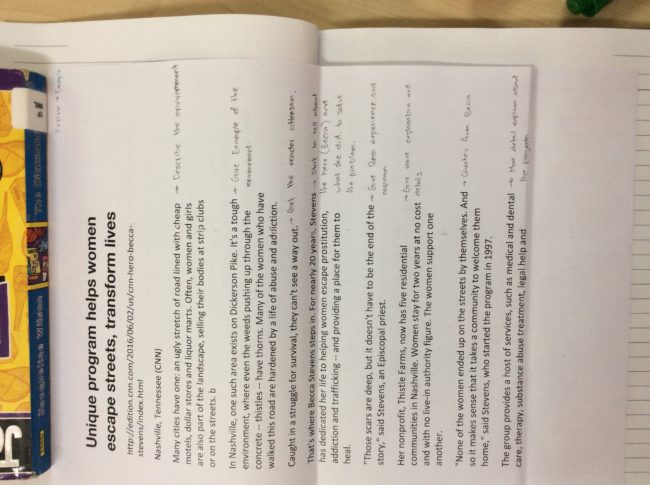 Step 3: Co-construct a Text
Step 3: Co-construct a Text
Then I have the ELs co-construct an example paragraph that contains that genre’s essential language features. I use this scaffold below to guide their co-construction. On the left side are the ideas I want students to have in their paragraph. On the right side are the language features that help them organize and connect ideas together. Students are paired up and given whiteboard and whiteboard markers to show their co-constructed paragraph. I learned about this scaffold from a workshop lead by Indu Bedi (2016).
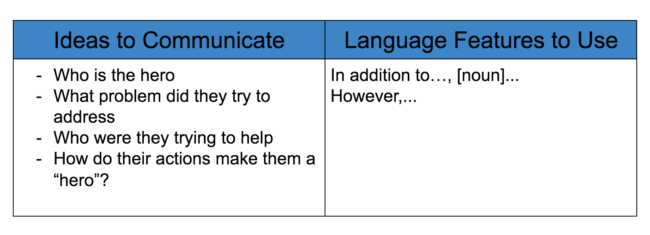 I repeated the process the following lesson when we deconstructed a body paragraph. This time, I had them identify the ideas that the paragraph was trying to communicate. They then wrote this on the left side of their white boards. After the finished writing the ideas, I asked them to identify the words and phrases used to connect sentences together. They wrote these things on the right side of the board.
I repeated the process the following lesson when we deconstructed a body paragraph. This time, I had them identify the ideas that the paragraph was trying to communicate. They then wrote this on the left side of their white boards. After the finished writing the ideas, I asked them to identify the words and phrases used to connect sentences together. They wrote these things on the right side of the board. 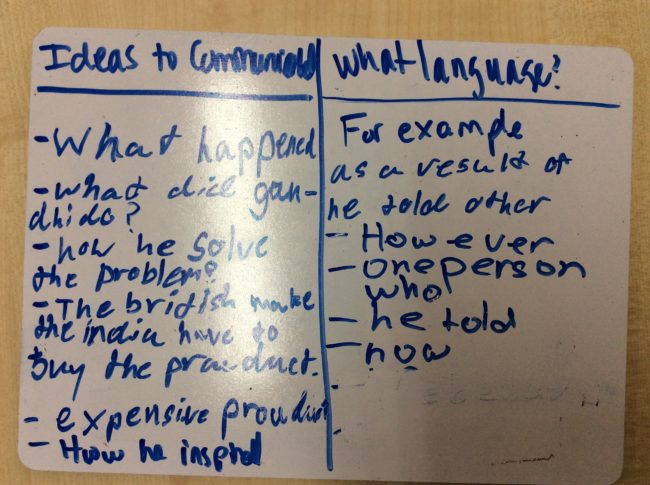
This co-construction process is an important step before writing because it acts as a scaffold to students crafting their own text; they become part of the drafting process (Gibbons, 2009). During the co-construction, the mental work of writing that was once invisible is now more evident to the students.
Step 4: Student Construction
After deconstructing a mentor text and co-constructing an example with the teacher, students are finally ready to practice their own writing. Their student-created outlines contain their ideas and thoughts on organization. Their annotated mentor texts remind them of the language features of the text type. They are ready to begin. After five minutes of writing, I visit with one student at time to conference with them over their process.
One quick note: this process works best if the first paragraphs deconstructed are body paragraphs. The introductions and conclusions can be addressed separately at a later session. Otherwise, the students may be overloaded.
This is an image of Jane using her outline and the deconstructed mentor text to draft her own text.
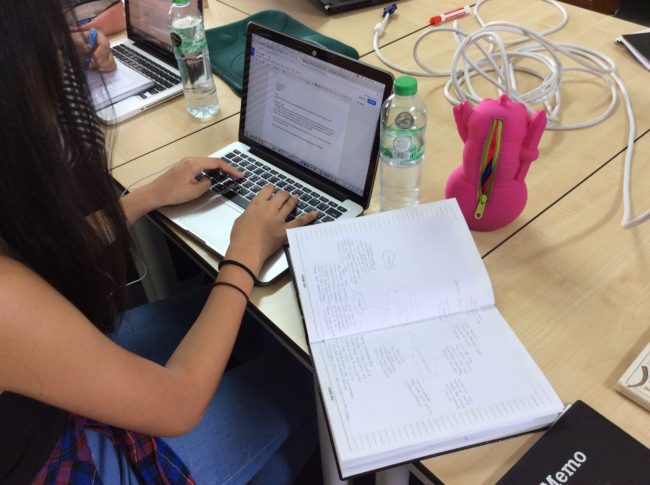 For my younger ELs, I have them take their split screen boards and being writing only the paragraph that we deconstructed together because they now have a better understanding of how to write that paragraph. I want to reduce the amount of time between when they learned the language features and when they actually produce their own texts. Below is an image of Dhong and Long writing their body paragraphs right after they have processed the ideas and captured the language features on their split-screen white boards.
For my younger ELs, I have them take their split screen boards and being writing only the paragraph that we deconstructed together because they now have a better understanding of how to write that paragraph. I want to reduce the amount of time between when they learned the language features and when they actually produce their own texts. Below is an image of Dhong and Long writing their body paragraphs right after they have processed the ideas and captured the language features on their split-screen white boards.
In Defense of Teacher-Created Mentor Texts
I know that some criticize providing students with any teacher-created mentor texts (invoking the “Grecian Urn”). Critics argue that the teacher-text, an inauthentic composition, is often too rigid to demonstrate the natural progressive flow of ideas. For example, opponents dislike teachers prescribing the “Five Paragraph Essay” format because such an essay does not exist in real-world texts such as news and magazine articles, or chapters in books.
While I also caution against a formulaic style of writing instruction, the principle behind the “Five Paragraph Essay” does have merit: it provides ELs at the Entering and Emerging phases of language with a basic model of writing. Without a primitive model and a pre-described structure, writing is often a paralyzing experience for ELs, which causes them to self-identify as “struggling” students.
Here’s an example from my 6th-grade class. The 6th-grade Humanities instructor was teaching about ancient civilizations, and I saw an opportunity to teach non-fiction reading and expository writing. I used the content in Humanities class to teach my 6th graders the writing process in English class.
Students’ writing prompt was: Life in Athens consisted of many systems. Describe these Athenian systems. Evaluate how the Athens systems treated men and women. Because that particular 6th-grade class had many students at the Entering and Emerging phases, I chose to use a teacher-created text.
But instead of writing about Athens, I chose to write about the systems at our school. The prompt for the teacher-created text was: Describe the systems at VIS. Evaluate how these systems treat the students. My teacher text communicates ideas just like the one for the writing assignment, but the topic is different to prevent students from just copying.
Below is an image of the teacher-created text that I crafted to help students develop their writing skills. Clicking on it will send you to the actual document.
In my text, I identified each of the type of paragraphs (introduction, body, and conclusion), provided a paragraph (to introduce the topic, to provide details, and to produce a new insight), and included an image for further scaffolding. The real learn does not come from the mentor text, but rather, the deconstruction process.
An Analogy
Olympic gymnasts often have a “signature move” that is comprised of a series of extremely difficult moves. However, to achieve the difficulty of this “signature move”, they first had to master the basics of simpler moves like cartwheels, handstands, and forward rolls.
Similarly, to help students write with dynamic, authentic voices, we must develop ELs skill sets gradually, without killing the joy of writing . In addition to skills training, we have to develop their awareness of writing style by allowing them to reflect on their process. Doing so will help them develop their own style and tone – their own unique voice.
Simply put, learning basic skills empowers them to write well in the future. Writing develops an awareness of how the skills work. Using the skills with discretion forges a unique, individual voice.
Takeaways
- Writing is an invisible task.
- Deconstructing mentor texts with ELs teaches the way language is used in different genres.
- Teaching students to think metacognitively about the writing process helps them transfer writing skills to other contexts.
Next Post
It has taken me years to figure out how to support ELs during the writing process. The strategy in this article may take the longest to teach, but it’s also one of the best models to teach the process of writing that I have encountered.
Next week’s article continuing the Visible Literacy series will share with you a framework to teach revision. I’ll see you here again next week.
References
Bedi, I. (2016). Scaffolding Writing Across the Curriculum: An EAL Approach. Penarth, UK: Dragonfly EAL.
Derewianka, B., & Jones, P. (2013). Teaching Language in Context. Melbourne: Oxford University Press.
Gallagher, K. (2006). Teaching Adolescent Writers. Portland, ME: Stenhouse.Gibbons, P. (2009). English Learners, Academic Literacy, and Thinking: Learning in the Challenge Zone. Portsmouth: Heinemann.
Hattie, J. (2012). Visible Learning for Teachers: Maximizing Impact on Learning. London: Routledge.
Hyland, K. (2014). Genre and Second Language Writing. Michigan: University of Michigan Press.
Martin, J.R., & Rose, D. (2012). Learning to Write, Reading to Learn: Genre, Knowledge and Pedagogy in the Sydney School. Bristol: Equinox.
Riddett, C. (2015, April 2). The Teaching Learning Cycle. Retrieved from https://www.linkedin.com/pulse/teaching-learning-cycle-christopher-riddett
Toner, K. (2016, June 3). Retrieved August 20, 2016, from http://edition.cnn.com/2016/06/02/us/cnn-hero-becca-stevens/index.html


